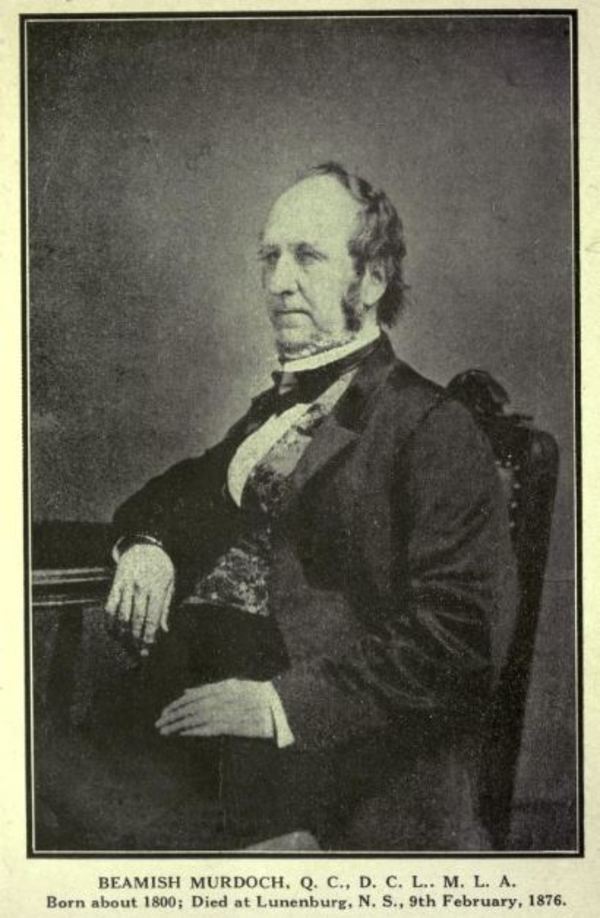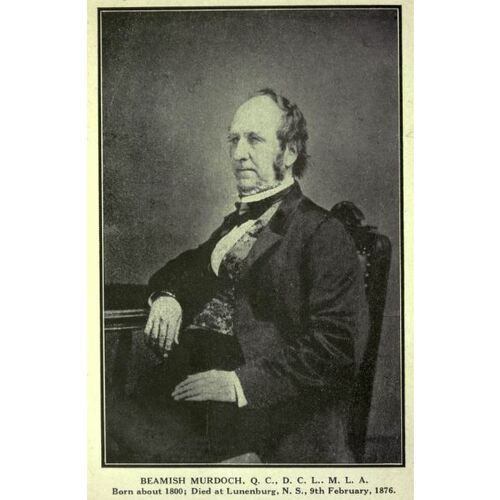
Source: Link
MURDOCH, BEAMISH, writer, lawyer, and politician; b. to Andrew Murdoch and Elizabeth Beamish at Halifax, N.S., 1 Aug. 1800; d. in Lunenburg, N.S., 9 Feb. 1876.
Beamish Murdoch was raised and educated by a maiden aunt, Harriet Jane Ott Beamish, after his father, a merchant, became involved in an expensive lawsuit and was jailed as a debtor for seven years. In 1822 Murdoch was admitted to the bar of Nova Scotia and began a legal practice. He also began to contribute articles to the Acadian Recorder, which was owned by Philip J. Holland (d. 1839), and to the Acadian Magazine or Literary Mirror, which began publication in Halifax in 1826. Although his grandfather, the Reverend James Murdoch, had been a missionary in the Antiburgher wing of the Church of Scotland, Beamish Murdoch was raised in the Church of England and belonged to St Paul’s Church. In the disruption of that church in 1824 he joined the faction which included Thomas Chandler Haliburton*, and moved to St George’s Church in Halifax [see J. W. Johnston].
In 1826, Murdoch, aided by his uncle, Thomas Ott Beamish, ran for the House of Assembly for Halifax Township. In spite of opposition from the city merchants, he had sufficient strength in the township to carry the election. Murdoch, who in 1824 and 1825 had been vice-president of the Charitable Irish Society, also received aid from the Irish, and in the assembly he worked to remove civil disabilities from the Roman Catholics. He quickly became an active member, generally following Haliburton’s lead. Thus, in 1827, when a question arose concerning the right of the legislature to control customs revenue, Murdoch supported Haliburton’s proposal that the assembly should petition the crown seeking a compromise measure which would give it some control over future revenue expenditures. Murdoch was irritated over the refusal of the Legislative Council, which included Hibbert N. Binney, the collector of customs, to support the move. He was further annoyed when the upper house failed to support his motion requesting that the crown reverse its decision to collect quitrents. He did not deny the constitutional right of Great Britain to enforce payment but argued that the measure was unjust. A real conflict with the upper house did not develop until 1830 when the two houses clashed over the duty on brandy [see Enos Collins]. Murdoch, who followed the lead of Samuel George William Archibald*, regarded the action of the council as unconstitutional and argued that the council’s stand denied the lower house the authority which it should possess as the representative of the people.
In the election of 1830 Murdoch ran against Stephen Wastie DeBlois. He received support from Joseph Howe and the Novascotian despite the fact that Howe had criticized Murdoch during the legislative session of 1830. Prior to 1830 Murdoch had supported public grants to Pictou Academy, but he, like Haliburton, apparently objected to attacks on Bishop John Inglis* by the academy’s president, Thomas McCulloch*. Howe, in turn, felt that Murdoch had made unwarranted attacks on McCulloch. Any chance of Murdoch’s carrying the election in 1830 was ended when he was provoked into complaining about so-called loyalists who fled the United States to escape bad debts and monopolized public offices in the province. After the election, Murdoch withdrew from public affairs until the campaign of 1836 when he ran, unsuccessfully, against a Reformer. In the 1840 election he ran against Joseph Howe and William Annand* and again was defeated. During the 1840 campaign, Murdoch complained that the Reformers’ demands for responsible government threatened the tie with England and would upset the balance in the British constitutional system. By the time he wrote his history of the province, however, he had come to regard cabinet government and self-government as being compatible with association in the British empire.
During his withdrawal from public affairs in the early 1830s, he prepared his four-volume Epitome of the laws of Nova Scotia, printed by Joseph Howe in 1832–33. This work, which involved a detailed study of the provincial and English law, was modelled after Sir William Blackstone’s Commentaries. Murdoch’s work was well received by the Maritime press and was apparently a significant contribution to both lawyers and law students until the growing body of provincial law made it obsolete and more specialized works made it unnecessary.
Throughout his life Murdoch showed a keen interest in education, in charitable institutions., and in moral issues. In January 1825 he was appointed joint secretary of the Poor Man’s Friend Society and in the 1830s he served on the Nova. Scotia Philanthropic Society. His interest may, have been sparked by the experiences of his father and in 1826 he wrote a pamphlet in which he supported the introduction of a bankruptcy law. Murdoch was an early supporter of temperance. and, by 1842, was president of the Halifax Temperance Society, which had been established in 1832. His concern with public education led him to serve on the Halifax Library Committee in the 1840s and 1850s. He assumed a more significant role in provincial education when he became clerk of the Central Board of Education in April 1841. As clerk, he earned an annual salary of £150 and played an important part in the board’s attempts to establish a uniform school system in the province. He prepared a summary of the ordinances of the city of Halifax in 1851 and, in October 1852, was appointed recorder for the city with an annual salary of £200. As recorder he was required to offer legal advice to the city and to try cases before the mayor’s court.
When he retired in 1860 Murdoch began to prepare A history of Nova Scotia, or Acadie, which was published in installments between 1865 and 1867. He originally intended the history to end with the year 1807 but extended it to the year 1827. He even considered going as far as 1867 but his energy, or perhaps the public response to the first three volumes, was not equal to the task. In his work he adopted a severely chronological approach, with extensive quotations from documents and earlier books. There was no critical appraisal of the documents, nor was there any sense of development through time. Murdoch was so convinced of the universal truth of his beliefs that he expected his reader to perceive the real nature of liberty, loyalty, and progress merely by seeing the actual words of the pioneers. He felt no compulsion to expound on his beliefs, but assumed that they were inherent in the British race. Thus, according to his History, as soon as the English arrived in Nova Scotia, the province began to take on an English aspect. The British belief in law, freedom, and industry helped preserve the province from the convulsions of revolution which racked the United States and was gradually adapted to the local environment. Thus, he was able to reconcile a faith in a Nova Scotian nationalism with a continued loyalty to Great Britain. Intended as a delineation of the Nova Scotian character, Murdoch’s work stands as a monument to chronology as history.
Beamish Murdoch, The charter and ordinances of the city of Halifax in the province of Nova Scotia with the provincial acts concerning the city, collected and revised by authority of the city council (Halifax, 1851); An epitome of the laws of Nova Scotia (4v., Halifax, 1832–33); An essay on the mischievous tendency of imprisoning for debt (2nd ed., Halifax, 1831); A history of Nova Scotia, or Acadie (3v., Halifax, 1865–67); A narrative of the late fires at Miramichi, New Brunswick: with an appendix containing the statements of many of the sufferers, and a variety of interesting occurrences; together with a poem, entitled “The conflagration” (Halifax, 1825).
PANS, Beamish Murdoch papers. Duncan Campbell, Nova Scotia in its historical, mercantile, and industrial relations (Montreal, 1873), 268–77. Directory of N.S. MLAs (Fergusson), 262. G. E. Hart, “The Halifax Poor Man’s Friend Society, 1820–27. An early social experiment,” CHR, XXXIV (1953), 109–23. D. C. Harvey, “History and its uses in pre-confederation Nova Scotia,” CHA Report, 1938, 5–16. D. C. Harvey, “Nova Scotia’s Blackstone,” Can. Bar Rev., XI (1933), 339–44. Gene Morison, “The Brandy Election of 1830,” N.S. Hist. Soc. Coll., XXX (1954), 151–83. H. L. Stewart, The Irish in Nova Scotia: annals of the Charitable Irish Society of Halifax (1786–1836) (Kentville, N.S., [1949]), 138–41. Norah Story, “The church and state ‘party’ in Nova Scotia, 1749–1851,” N.S. Hist. Soc. Coll., XXVII (1947), 35–57. K. N. Windsor, “Historical writing in Canada to 1920,” Lit. hist. of Can. (Klinck), 208–50.
Cite This Article
K. G. Pryke, “MURDOCH, BEAMISH,” in Dictionary of Canadian Biography, vol. 10, University of Toronto/Université Laval, 2003–, accessed January 18, 2026, https://www.biographi.ca/en/bio/murdoch_beamish_10E.html.
The citation above shows the format for footnotes and endnotes according to the Chicago manual of style (16th edition). Information to be used in other citation formats:
| Permalink: | https://www.biographi.ca/en/bio/murdoch_beamish_10E.html |
| Author of Article: | K. G. Pryke |
| Title of Article: | MURDOCH, BEAMISH |
| Publication Name: | Dictionary of Canadian Biography, vol. 10 |
| Publisher: | University of Toronto/Université Laval |
| Year of publication: | 1972 |
| Year of revision: | 1972 |
| Access Date: | January 18, 2026 |



